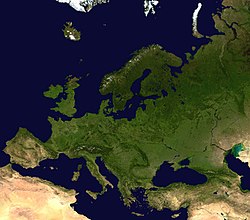Spanske armada

For den nuværende spanske flåde, se Armada Española.
Den Spanske Armada eller "Den Store Armada" (sp.: Grande y Felicísima Armada, "den store og lykkebringende flåde"; af englænderne ironisk kaldt "the Invincible Fleet" ("den uovervindelige flåde") var den spanske flåde (eller armada), som i 1588 på kong Filip 2.'s ordre sejlede mod England under kommando af Alonso Pérez de Guzmán, hertug af Medina Sedonia. Angrebet var en hævn for henrettelsen af den katolske Maria Stuart af Skotland og engelske kapringer af spanske skibe i Caribien.
Armadaen nåede efter to måneder frem til Den Engelske Kanal. Men englænderne var parate, og de gik til angreb på de store spanske krigsskibe med mindre mere manøvredygtige skibe. Spanierne led tab under søslaget ved Gravelines 8. august (18. august efter den gregorianske, nutidige kalender) 1588 og trak op i Nordsøen. En invasion af England blev hermed undgået.
Fra Nordsøen forsøgte Armadaen at undslippe ved at sejle nord og vest om De Britiske Øer, men som følge af fejlagtig navigation og manglende kendskab til Golfstrømmens indvirkning på skibenes position valgte Armadaen en kurs forholdsvis tæt på Skotlands og Irlands vestkyst. Grundet kraftige vestlige storme, der ikke var usædvanlige under den lille istid, blev adskillige af Armadaens skibe drevet mod de irske og skotske klipper, hvor de strandede eller blev knust. Kun ca. halvdelen af de spanske skibe nåede hjem til Spanien.[1]
Noter
Eksterne links
- Catholic Encyclopedia (1913)/Spanish Armada fra Wikisource (engelsk)
- Top 10 myths and muddles about the Spanish Armada Arkiveret 18. februar 2020 hos Wayback Machine (engelsk)
| Spire |
|
Koordinater: 50°10′00″N 4°15′42″V / 50.1667°N 4.2617°V
Medier brugt på denne side
English ships and the Spanish Armada, August 1588.
The painting may have been a design for a tapestry, or if not is laid out like one, and is dateable to the years immediately following the event. The composition appears less like a painting than as a formal design in a mannered style but no other contemporary image of the Armada conveys a comparable sense of the drama and colour of the confrontation between the two fleets. Although it is not exactly clear which part of the battle is shown (if indeed it is literal at all), it is most likely to be the action of Gravelines, the only point at which large numbers of ships from both sides were engaged in sustained conflict. However, the emblematic foreground arrangement of a Spanish galleass flanked by two English warships suggests that the picture was intended primarily as a symbol of the Armada campaign as a whole - although it is a symbol edged with satire. The galleass flies the Papal banner and the arms of Spain but her complement includes a number of figures - many portrayed as sinister zealots - led by a preaching monk, and a death's head or skeleton in a jester's costume. This renders her a 'ship of fools', an image originated and popularized by Sebastian Brandt's illustrated moral fable, 'Das Narrenschiff', of 1494. In this case the quietly humorous anti-Catholic invective is heightened by a representation of a distraught Spaniard - perhaps meant for Phillip II or the Armada's commander, the Duke of Medina Sidonia - in a boat near the stern. Elsewhere monks disappear beneath the waves as the battle rages. The galleass may also be meant to represent the principal Spanish flagship, Medina Sidonia's 'San Martin', 48 guns, although by showing her as a galleass, when she was in fact a galleon, the artist has used poetic licence to emphasize her Spanish origin. To her right is a stern view of what is clearly intended as the 'Ark Royal', 55 guns, the flagship of the English Lord Admiral, Lord Howard of Effingham, flying the Elizabethan Royal Standard. On the left, bow on, is another English ship, perhaps Drake's vice-admiral's flagship, 'Revenge', 43 guns, although this is speculative. Beyond them the panel is filled with fighting and sinking vessels. The ships, particularly those in the foreground, are painted with care and some accuracy of detail. Generally the proportions of the hulls, masts and yards are credible for warships of this period. Like many English observers the artist was evidently impressed by the few galleasses in the Spanish fleet. There were in fact four which reached the Channel, all from Naples, though only two survived to reach safe harbour. The varied Spanish and English ships seen in the background include, in the far distance, one single-masted barge-like vessel, possibly of Dutch origin or at least an allusion to the Dutch Protestant 'sea beggars role in harrying the Armada in and after the battle off Gravelines.
oil on poplar panel
Measurements Frame: 1380 mm x 1700 mm x 110 mm; Painting: 1120 mm x 1435 mmis almost identical to that of 1. Versailles version but signed



